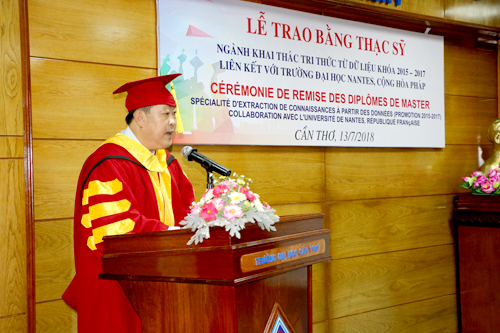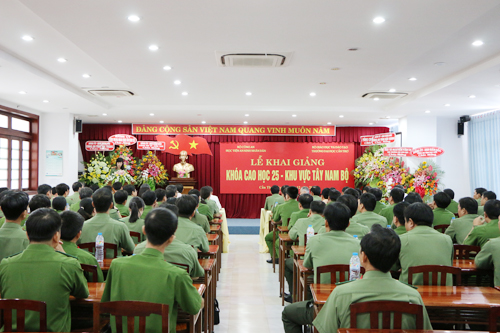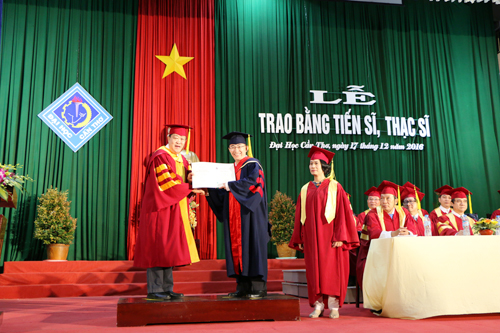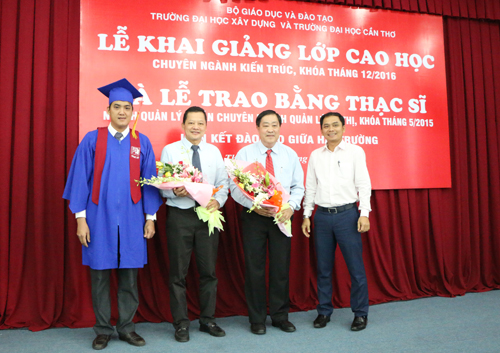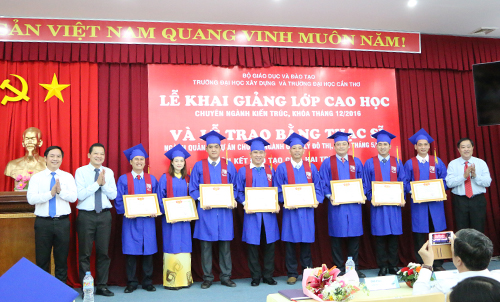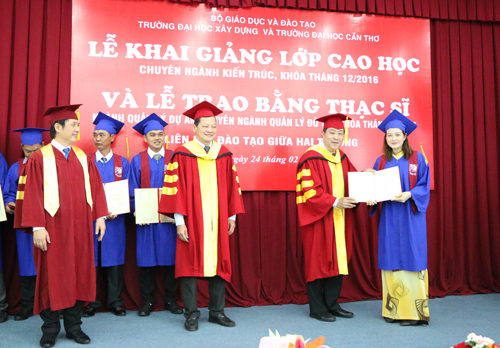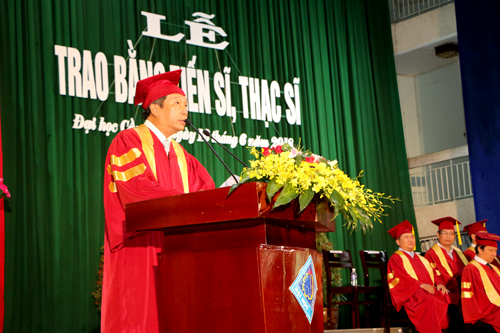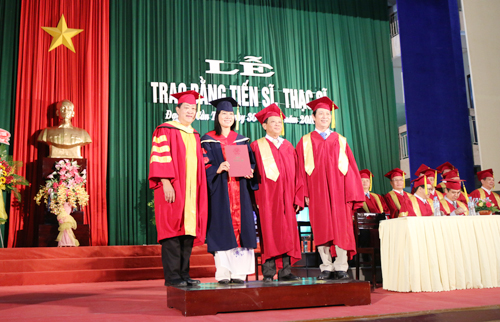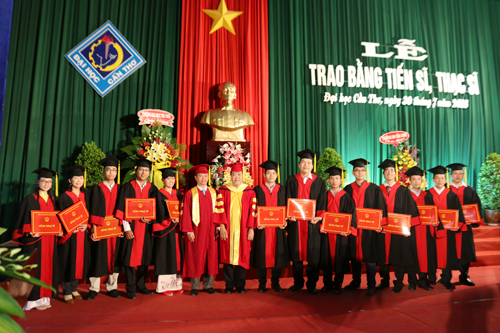
Tên đề tài: “Ảnh hưởng của nhiệt độ và CO2 cao lên tăng trưởng và phát triển của tôm sú (Penaeus monodon Fabricius, 1798) và tôm thẻ chân trắng (Litopenaeus vannamei Boone, 1931)”.
Tác giả: Đỗ Văn Bước, Khóa: 2015
Chuyên ngành: Nuôi trồng thủy sản; Mã số: 62620110. Nhóm ngành: Nông-Lâm-Ngư nghiệp
Người hướng dẫn chính: GS.TS. Nguyễn Thanh Phương - Trường Đại học Cần Thơ
Người hướng dẫn phụ: PGS.TS. Châu Tài Tảo - Trường Đại học Cần Thơ
1. Tóm tắt nội dung luận án
Luận án được thực hiện với các nội dung gồm khảo sát sự biến động các yếu tố môi trường nước trong ao nuôi tôm sú và tôm thẻ chân trắng thâm canh; nghiên cứu ảnh hưởng của nhiệt độ và CO2 cao lên sự phát triển của tôm sú và tôm thẻ chân trắng bao gồm ảnh hưởng lên phát triển phôi, tỉ lệ nở, chiều dài ấu trùng và hậu ấu trùng, tỉ lệ sống ấu trùng PL15, ảnh hưởng đến tăng trưởng và các chỉ tiêu sinh lý qua các giai đoạn từ ấu niên và tiền trưởng thành.
Các chỉ tiêu môi trường nước gồm nhiệt độ, pH, oxy hòa tan, CO2, độ kiềm và độ mặn khảo sát tại ao nuôi tôm ở 3 giai đoạn của chu kỳ nuôi gồm đầu vụ, giữa vụ và cuối vụ, tương ứng với các thời điểm sau khi thả giống là 15-20 ngày, 50-60 ngày và 80-90 ngày. Kết quả cho thấy ở ao tôm sú nhiệt độ dao động 29,3-29,7ºC, pH 7,82-8,04, oxy hòa tan 6,65-6,75 mg/L, CO2 3,18-3,50 mg/L, độ kiềm 79-102 mg/L và độ mặn 5,33-15,0‰. Ao nuôi tôm thẻ chân trắng thì nhiệt độ 28,9-29,5ºC, pH 7,82-8,07, oxy hòa tan 5,33-6,08 mg/L, CO2 4,16-4,70 mg/L, độ kiềm 145-191 mg/L và độ mặn 10-11‰.
Kết quả nghiên cứu ảnh hưởng của nhiệt độ và CO2 lên tôm sú cho thấy, tỉ lệ nở cao nhất ở 28oC (92,2%) và 30oC (90,3%) và nhiệt độ 34oC trứng không nở; thời gian phát triển phôi ngắn và chiều dài ấu trùng (PL15) dài hơn ở nhiệt độ 32oC, tỉ lệ sống PL15 cao nhất ở 28oC (50,8%). Tỉ lệ nở và tỉ lệ sống của tôm giảm đáng kể ở nồng độ CO2 cao, ở nồng độ 44-45 mg/L (tương đương pH=6,8) trứng không nở; nồng độ CO2 cao phôi chậm phát triển và chiều dài ấu trùng nhỏ hơn so với hàm các nghiệm thức khác. Tỉ lệ nở và tỉ lệ sống bị ảnh hưởng tương tác bởi nhiệt độ và CO2, nhiệt độ cao và CO2 cao giảm đáng kể tỉ lệ nở và tỉ lệ sống PL15, trong khi đó chiều dài ấu trùng không bị ảnh hưởng tương tác. Ương tôm sú ở giai đoạn ấu niên cho thấy tăng trưởng khối lượng và chiều dài tôm cao nhất ở nghiệm thức 30-31oC và thấp nhất ở 27-28oC; tỉ lệ sống cao nhất ở nghiệm thức 27-28oC (65%) và nghiệm thức không kiểm soát nhiệt độ (63,7%), nhiệt độ 36-37oC sau 15 ngày tôm chết hoàn toàn; glucose, enzyme tiêu hóa tăng cao ở nhiệt độ cao (33-34oC). Tăng trưởng, tỉ lệ sống, enzyme tiêu hóa giảm khi hàm lượng CO2 tăng cao, hàm lượng glucose cao nhất ở nghiệm thức CO2 là 43,9 mg/L. Các chỉ tiêu tăng trưởng, enzyme tiêu hóa, glucose, tỉ lệ sống của tôm không bị ảnh hưởng tương tác bởi nhiệt độ và CO2. Giai đoạn tiền trưởng thành thì ở nhiệt độ 33-34°C tăng trưởng cao nhất và thấp nhất ở nhiệt độ 27-28oC; hoạt tính enzyme tiêu hoá, glucose gia tăng theo sự gia tăng của nhiệt độ; tỉ lệ sống tôm sú cao nhất nghiệm thức không kiểm soát nhiệt độ (68,3%) và thấp nhất ở 36-37oC (0%), nhiệt độ cao ảnh hưởng đến lớp biểu bì của mang tôm sú. Hàm lượng CO2 cao làm giảm các chỉ tiêu tăng trưởng, tỉ lệ sống, hoạt tính enzyme tiêu hóa và làm tăng hàm lượng glucose trong máu tôm; lớp biểu bì mang tôm ở hàm lượng CO2 cao (44,7 mg/L) trở nên mỏng hoặc biến mất; nhiệt độ cao kết hợp với CO2 không ảnh hưởng tương tác lên tăng trưởng, enzyme tiêu hóa, glucose, tỉ lệ sống của tôm sú.
Kết quả của Luận án cũng cho thấy tôm thẻ chân trắng có tỉ lệ nở, tỉ lệ sống ấu trùng đến PL15 cao nhất ở nghiệm thức 28oC và 30oC, nhiệt độ cao thời gian phát triển phôi ngắn và chiều dài ấu trùng dài hơn; hàm lượng CO2 cao làm giảm tỉ lệ nở, tỉ lệ sống, chiều dài ấu trùng và kéo dài thời gian phát triển phôi; kết hợp nhiệt độ và CO2 không ảnh hưởng tương tác lên tỉ lệ nở, tỉ lệ sống, chiều dài ấu trùng. Giai đoạn ấu niên tôm tăng trưởng nhanh ở nhiệt độ 36-37oC và 33-34oC, nhưng tỉ lệ sống giảm thấp; enzyme tiêu hóa, glucose gia tăng theo nhiệt độ cao. Tăng trưởng, tỉ lệ sống, enzyme tiêu hóa giảm khi hàm lượng CO2 tăng cao, hàm lượng glucose cao nhất ở hàm lượng CO2 là 45,6 mg/L (37,5 mg/100 mL); không có sự ảnh hưởng tương giác giữa nhiệt độ cao và CO2 lên tăng trưởng, hoạt tính enzyme tiêu hóa glucose, tỉ lệ sống của tôm. Tương tự, giai đoạn ấu niên nhiệt độ tăng cao tôm phát triển nhanh, nhiệt độ 33-34°C khối lượng và chiều dài đạt cao nhất (13,8 g và 11,3 cm) và thấp nhất ở nhiệt độ 27-28oC; hoạt tính enzyme tiêu hoá và hàm lượng glucose tăng ở nhiệt độ cao (33-34oC); tỉ lệ sống cao nhất ở nghiệm thức không kiểm soát nhiệt độ (79,2%), thấp nhất ở nhiệt độ 36-37oC (2,50±1,4%); nhiệt độ 33-34oC ảnh hưởng đến sự thay đổi cấu trúc mang tôm thẻ chân trắng so với nhiệt độ thấp; trong giai đoạn này hàm lượng CO2 cao gây ảnh hưởng đáng kể lên tôm thẻ chân trắng như giảm tăng trưởng, ức chế hoạt tính enzym tiêu hóa, gia tăng tình trạng căng thẳng (hàm lượng glucose trong máu cao) và tỉ lệ sống tôm giảm (15,8% ở hàm lượng 44,1 mg/L); có sự thay đổi về đặc điểm cấu trúc mang tôm khi tiếp xúc với hàm lượng CO2 cao như một số sợi mang không còn tồn tại lớp biểu bì, khoảng không dưới lớp biểu bì không còn hiện diện so với mang tôm tiếp xúc hàm lượng CO2 thấp; nhiệt độ cao kết hợp với CO2 có ảnh hưởng tương tác lên tăng trưởng của tôm, trong khi đó hoạt tính enzyme tiêu hóa, glucose, tỉ lệ sống không bị ảnh hưởng.
Như vậy, kết luận của Luận án cho rằng nhiệt độ và CO2 cao tác động tiêu cực đến quá trình tăng trưởng, tỉ lệ nở, tỉ lệ sống và một số chỉ tiêu sinh lý của tôm sú và tôm thẻ chân trắng ở các giai đoạn từ phôi đến tiền trưởng thành.
- Những kết quả mới của luận án
Xác định được ảnh hưởng của CO2, nhiệt độ và ảnh hưởng có tương tác giữa CO2 và nhiệt độ lên phát triển phôi, tỉ lệ nở của trứng, tỉ lệ sống PL15; tăng trưởng và tỉ lệ sống giai đoạn ấu niên và tiền trưởng thành của tôm sú và tôm TCT.
Xác định được sự thay đổi hoạt tính enzyme tiêu hoá, glucose và cấu trúc mang do ảnh hưởng CO2 và nhiệt độ cao cũng như sự tương tác của hai yếu tố này đến tôm sú và tôm TCT.
- Các ứng dụng/khả năng ứng dụng trong thực tiễn, các vấn đề cần tiếp tục nghiên cứu:
Nghiên cứu cung cấp và bổ sung thông tin về ảnh hưởng của nhiệt độ và CO2 cũng như mối tương tác của chúng lên đặc điểm sinh lý và tăng trưởng của tôm sú và tôm TCT. Nghiên cứu này đánh giá toàn diện về ảnh hưởng của CO2 và nhiệt độ lên sự phát triển phôi, sinh trưởng và các chỉ tiêu sinh lý như enzyme tiêu hóa, hàm lượng glucose trên tôm sú và tôm TCT. Kết quả của nghiên cứu là cơ sở khoa học góp phần đánh giá ảnh hưởng của điều kiện biến đổi khí hậu lên ngành nuôi trồng thủy sản nói chung và nghề nuôi tôm sú và tôm TCT ở vùng ven biển nói riêng. Kết quả nghiên cứu cũng giúp các nhà khoa học và người nuôi tôm nhận biết được ảnh hưởng có lợi và bất lợi của nhiệt độ và CO2 lên tôm sú và tôm TCT, là cơ sở giúp người nuôi ứng dụng ảnh hưởng tốt của việc duy trì nhiệt độ cao ở mức thích hợp nhằm tăng cường hoạt động trao đổi chất của tôm ảnh hưởng tốt đến tăng trưởng có thể tăng năng suất nuôi tôm sú và tôm TCT, đồng thời cũng giúp người nuôi tôm nhận biết được những yếu tố bất lợi của CO2 lên phôi, ấu trùng, hậu ấu trùng, tôm ấu niên và tiền trưởng thành của tôm sú và tôm TCT, từ đó có những biện pháp hạn chế sự tồn tại của CO2 cao trong ao nuôi. Bên cạnh, ý nghĩa khoa học và thực tiễn của kết quả nghiên cứu cũng là nguồn tài liệu tham khảo quan trọng và phong phú phục vụ cho giảng dạy và các nghiên cứu tiếp theo liên quan đến tôm sú và tôm TCT hoặc các nghiên cứu liên quan đến biến đổi khí hậu đối với các đối tượng giáp xác khác.
- Summary of dissertation
The research included the contents: a survey on the fluctuations in water environmental parameters in intensive shrimp farming of black tiger shrimp and white leg shrimp ponds; Effects of high temperature and CO2 on the growth performance of black tiger shrimp and white shrimp (embryo development, hatching rate, growth of larvae and post-larvae in length, survival rate of PL15 stage) as well as growth performance and physiological parameters through from juvenile to subadult stages
Water environmental parameters including temperature, pH, dissolved oxygen, CO2, alkalinity and salinity were surveyed in shrimp ponds at 3 stages of the faring crop (after the stocking day of 15-20 days, 50-60 days and 80-90 days, respectively). The recorded results in black tiger shrimp ponds included: temperature of 29.3-29.7ºC, pH of 7.82-8.04, dissolved oxygen of 6.65-6.75 mg/L, CO2 of 3.18-3.50 mg/L, alkalinity of 79-102 mg/L and salinity of 5.33-15.0‰. For the obtained results in white leg shrimp ponds: temperature of 28.9-29.5ºC, pH of 7.82-8.07, dissolved oxygen of 5.33-6.08 mg/L, CO2 of 4.16-4.70 mg/L, alkalinity of 145-191 mg/L and salinity of 10-11‰.
The results on the effects of temperature and CO2 on black tiger shrimp indicated that the highest hatching rate was recorded at the treatment of 28oC (92.2%) and 30oC (90.3%) while, at 34oC treatment, the embryo did not hatch. In the 32oC treatment, the embryo development time was shorter and the length of (PL15) was longer than those in the other treatments. The survival rate in the PL15 stage was highest in the 28oC treatment (50.8%). Hatching and survival rates of shrimp were significantly reduced when exposing to high CO2 concentrations and in the treatment of 44-45 mgCO2/L, the eggs did not hatch. At high CO2 concentration, the embryo development was delayed and larval length was shorter than those of other treatments. Hatching and survival rates were influenced by temperature and CO2 in which high temperature and CO2 concentration significantly reduced hatching and survival rates at PL15 stage, while growth in length was not affected by the interaction between temperature and CO2. At the juvenile stage of black tiger shrimp, the growth in weight and length of shrimp were highest in treatment of 30-31oC and lowest in treatment of 27-28oC. The highest survival rate was recorded in the 27-28oC treatment (65%) and the normal temperature treatment (63.7%). At 36-37oC, shrimp died completely after 15 days of culture. Glucose concentration and digestive enzyme activities increased at high temperatures (33-34oC). Growth performance, survival rate, and digestive enzyme activities decreased when exposing to high CO2 concentrations of which the highest glucose concentration was observed in the 43.9 mg CO2/L treatment. Growth performance, digestive enzyme activity, glucose concentration, and survival rate of shrimp were not affected by the interaction between temperature and CO2. In the subadult stage, at 33-34°C, growth performance was highest and in treatment of 27-28oC, the obtained growth performance was lowest. Digestive enzyme activity, glucose concentration increased with increasing temperature exposure. The survival rate of black tiger shrimp was highest at normal temperature (68.3%) and lowest at 36-37oC (0%). High temperature affected on the epidermis on the gills of black tiger shrimp. High CO2 concentrations decreased growth performance, survival rate, digestive enzyme activity and increase glucose concentrations in hemolymph. The epidermis in the gills of shrimp became thin or disappeared when exposing to high CO2 concentrations (44.7 mg/L). There was no interaction effect between CO2 and temperature on growth performance, digestive enzyme activity, glucose concentration and survival rate of black tiger shrimp.
In white leg shrimp, the hatching rate and survival rate of PL15 were highest at treatments of 28oC and 30oC. At high temperatures, embryo development time was shorter and growth in length was longer. At high CO2 concentration, hatching rate, survival rate and growth in length decreased as well as the duration of embryo development was prolonged. Temperature and CO2 had no interactive effects on hatching rate, survival and growth in length of shrimp. In the juvenile stage, shrimp grew rapidly in the treatments of 36-37oC and 33-34oC, but the survival rate decreased low. Digestive enzyme activity and glucose concentration increased with high-temperature exposure. Growth performance, survival rate, and digestive enzyme activity decreased when exposing to high CO2 concentrations. The highest glucose concentration was recorded (37.5 mg/100 mL) in the treatment of 45.6 mgCO2/L. There was no interaction effect between high temperature and CO2 on growth performance, digestive enzyme activity, glucose concentration and survival rate of shrimp. In the juvenile stage, high temperature led to rapid growth performance in which, at 33-34°C, growth in weight and length were highest (13.8 g and 11.3 cm, respectively) and the lowest ones were recorded in the treatment of 27-28oC. Digestive enzyme activity and glucose concentration increased when exposing to high temperature (33-34oC). The highest survival rate was obtained in the normal temperature treatment (79.2%) and the lowest one was found in the treatment of 36-37oC (2.50±1.4%). Range of 33-34oC affected the changes of morphology on gills of white leg shrimp. At this juvenile stage, high CO2 concentration had significant effects on white leg shrimp such as: decreasing growth, inhibiting of digestive enzyme activity, increasing stress (high glucose concentration in hemolymph) and decreasing shrimp survival rate (15.8% at the treatment of 44.1 mgCO2/L). There were some changes on the morphology on gills of shrimp exposing to high CO2 concentrations such as: the epidermis on gill filaments disappeared and the sub-epidermal space was narrowed compared to gills of shrimp exposing to low CO2 concentrations. There was an interaction effect between high temperature and CO2 on shrimp growth performance, while digestive enzyme activity, glucose concentration and survival rate were not affected by the interaction between temperature and CO2.
In conclusion, the obtained results indicated that high temperature and CO2 had adverse effects on growth performance, hatching rate, survival rate and several physiological parameters of black tiger shrimp and white leg shrimp from embryo to subadult stages.
- New findings of the study
The study determined the effect of CO2 and/or temperature on embryo development, hatching rate, the survival rate of PL15; Growth performance and survival rate of juvenile and subadult stages of black tiger shrimp and white leg shrimp.
In addition, the results of the research evaluated the changes in digestive enzyme activity, glucose concentration and histological changes of gill morphology when exposing to high CO2 or/and temperature of black tiger shrimp and white leg shrimp.
- Significant contribution and application of the study and recommendations for intensive study.
The study supplemented knowledge about the effects of temperature or/and CO2 on physiological parameters as well as the growth performance of black tiger shrimp and white leg shrimp. This study has comprehensively assessed the effects of CO2 and temperature on embryonic development, growth performance and physiological parameters (digestive enzyme activities, glucose concentration) of black tiger shrimp and white leg shrimp. The obtained results were considered scientific basis contributing to the assessment of the effects of climate change scenario on the aquaculture industry generally and the farming of black tiger and white shrimp in the coastal areas particularly. The recorded results also provide information for scientists as well as shrimp farmers to identify the beneficial and detrimental effects of temperature and CO2 on black tiger shrimp and white leg shrimp so that farmers could utilize the positive effects in order to maintain the temperature at an appropriate range to enhance metabolic activity, improve growth to contribute to increasing shrimp productivity. In addition, the study also supported shrimp farmers to recognize the adverse effects of CO2 on the development of the embryo, larvae, post-larvae, juvenile and subadult stages of these shrimp so that farmers could have appropriate methods to control the high concentration of CO2 in the culture environment. Besides, the scientific and practical significance of the research results were also an important and potential source of references for teaching and further research related to these two species or climate change scenario-related studies on other crustaceans.
- Xem chi tiết nội dung luận án
- Xem thông tin đăng tải tại Website Bộ giáo dục và Đào tạo. (Nhập tên NCS vào ô tìm kiếm)





